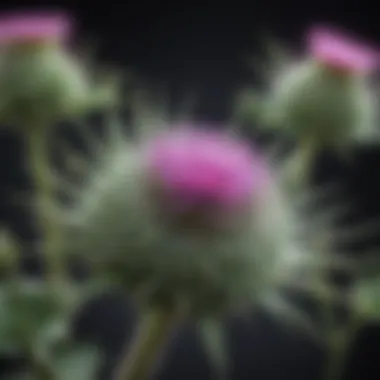Milk Thistle: A Potential Cancer Treatment


Intro
Milk thistle, scientifically known as Silybum marianum, has been recognized for its potential therapeutic uses, particularly in the realm of oncology. The active compound within milk thistle, silymarin, is associated with various health benefits, prompting researchers to explore its application in cancer treatment. The hepatoprotective properties of silymarin indicate its ability to protect liver cells during chemotherapy, which is one of the areas discussed in this article. Furthermore, the intriguing possibility that milk thistle may enhance the efficacy of traditional cancer therapies offers a compelling avenue for research.
As this exploration unfolds, the article will highlight significant findings from various studies, elucidate the biochemical pathways through which milk thistle may exert its effects, and assess its impact on the quality of life for cancer patients.
The engagement with this topic is essential, as cancer continues to pose substantial challenges globally, both in terms of treatment efficacy and patient well-being. An understanding of complementary and alternative therapies, such as milk thistle, may provide additional avenues for improving patient outcomes.
The subsequent sections will delve into the key findings from current research, outlining major results which illustrate the therapeutic potential of milk thistle. A thorough methodological overview will also be provided, detailing how the data was collected and analyzed to draw meaningful conclusions regarding this natural agent.
Intro to Milk Thistle
The exploration of milk thistle as a therapeutic agent holds substantial promise, particularly in the context of cancer treatment. This herbal remedy, deriving primarily from the Silybum marianum plant, has garnered attention in recent years due to its unique properties and potential health benefits. Understanding the foundations of milk thistle is crucial for comprehending its relevance in oncological care.
Milk thistle is not merely a botanical curiosity; its active component, silymarin, plays a pivotal role in its therapeutic potential. Silymarin has been studied for its hepatoprotective effects, immunomodulation, and antioxidant capabilities. This section will provide an overview of the plant as well as its historical applications in medicine.
Botanical Overview
Milk thistle, or Silybum marianum, is a thistle plant characterized by its striking purple flowers and spiny leaves. Native to the Mediterranean region, it has adapted well to various climates, making it a common sight in many parts of the world. The plant can grow up to 1.5 meters tall.
The name 'milk thistle' originates from the milky fluid found in its stems and leaves when crushed. This liquid reflects the plant’s potential medicinal benefits. The leaves are green and often decorated with white veins, providing a visually appealing aspect that makes this plant recognizable. The seeds of milk thistle, where silymarin is predominantly concentrated, are the part most often used in herbal supplements.
Historical Uses in Medicine
The medicinal use of milk thistle dates back thousands of years. Ancient Greeks and Romans recognized its protective qualities, especially concerning liver health. Hippocrates reportedly mentioned milk thistle for various ailments, including liver disorders. In medieval times, it was commonly utilized to treat liver diseases and bile-related conditions.
In more recent history, the 20th century saw a resurgence of interest in milk thistle due to scientific research on its active components. Studies began to confirm the hepatoprotective effects attributed to milk thistle, laying the foundation for modern herbal remedies. Today, practitioners of complementary medicine often recommend milk thistle as part of holistic treatment plans.
Milk thistle's enduring presence in medicinal history reflects its significance as a versatile therapeutic agent.
Thus, understanding the botanical characteristics and historical context of milk thistle sets the stage for examining its role in contemporary cancer therapies. Its historical applications support the ongoing research exploring the full spectrum of benefits that milk thistle may offer, particularly through its active ingredient silymarin.
The Active Component: Silymarin
Silymarin is the principal active compound derived from the seeds of the milk thistle plant, Silybum marianum. Its significance in cancer treatment emerges from its diverse pharmacological activities, primarily attributed to its antioxidant, anti-inflammatory, and membrane-stabilizing properties. The usage of silymarin is not merely a historical anecdote; rather, its relevance is underscored by a growing body of scientific literature that explores its therapeutic potential.
Chemical Composition
Silymarin is a complex mixture of flavonolignans, primarily including silibinin, silydianin, and silychristin. Among these, silibinin is often highlighted for its potent biological activities. The concentration of these compounds can vary widely depending on extraction methods and the part of the plant used. The standardization of silymarin in supplemental forms is critical because variations in composition can affect efficacy. Studies have shown that silibinin, in particular, can exert significant protective effects on the liver and has demonstrated the ability to modulate various biochemical pathways involved in cancer progression.
Mechanism of Action
The mechanism of action of silymarin in cancer therapy is complex and multifaceted. Notably, silymarin exhibits:
- Antioxidant Activity: Silymarin reduces oxidative stress by scavenging free radicals. This is vital since cancer cells often exploit oxidative stress to proliferate.
- Anti-inflammatory Properties: By inhibiting pro-inflammatory cytokines, silymarin may hinder inflammation-related cancer development and progression.
- Cellular Signaling Modulation: Silymarin influences key signaling pathways such as the NF-kB and MAPK pathways, contributing to its ability to suppress tumor growth and induce apoptosis in cancerous cells.
Research suggests that silymarin can enhance the efficacy of chemotherapeutic drugs. This synergistic effect can result in improved treatment outcomes for patients. However, understanding the full spectrum of silymarin's mechanisms requires further research, particularly in clinical settings.


"Silymarin has shown promise not only as a protective agent but also as an active participant in cancer treatment regimens. Its complex pharmacological profile warrants detailed investigation."
In summary, silymarin is not just a bioactive compound with isolated effects, but a vital component in the therapeutic landscape for cancer management. Further exploration of its biochemical interactions will undoubtedly pave the way for more effective cancer therapies.
Milk Thistle in Cancer Therapy
The exploration of milk thistle as a therapeutic agent in cancer treatment is a subject that warrants significant discussion. Silymarin, the active component in milk thistle, possesses properties that may address key challenges faced in oncology. The plant’s potential to enhance standard therapies, while also working to alleviate adverse side effects, positions it as a valuable adjunct in cancer care regimes. This section will dissect the complexities of cancer treatment challenges, examine silymarin’s specific roles, and discuss how it may help mitigate the uncomfortable side effects of conventional therapies.
Overview of Cancer Treatment Challenges
Cancer treatment poses numerous challenges for patients and healthcare providers. The diversity in cancer types necessitates a variety of treatment protocols, which often include chemotherapy, radiation, and surgery. Each approach has its own set of side effects. Common issues experienced by patients undergoing these treatments include nausea, fatigue, and compromised immune function. Additionally, many patients face emotional and psychological hurdles as they navigate their diagnosis and treatment plans.
Silymarin has been proposed as a supportive agent due to its hepatoprotective and antioxidant effects. These properties could provide significant help in improving patients’ overall health. However, research is still ongoing to understand fully how best to integrate milk thistle into treatment plans.
Silymarin's Role in Chemotherapy
Silymarin supports chemotherapy by potentially reducing toxicity associated with certain chemotherapeutic agents. This active compound can act as a protective shield for hepatocytes, the primary cells of the liver, which often suffer during chemotherapy. Studies suggest that silymarin may help maintain liver function, thus allowing patients to tolerate treatment more effectively. In some cases, it may enhance the efficacy of chemotherapy by protecting against oxidative stress caused by these drugs.
Research indicates that silymarin can influence the bioavailability of some anticancer drugs, possibly improving their effectiveness. However, the precise mechanisms through which silymarin interacts with these therapies require further exploration.
Potential to Mitigate Side Effects
One of the most compelling reasons for considering milk thistle in cancer therapy is its potential to mitigate side effects. Side effects like nausea, vomiting, and malaise can significantly reduce the quality of life for cancer patients. Silymarin has demonstrated promise in reducing these effects. For instance, some studies have shown a decrease in chemotherapy-induced liver toxicity, which can lead to improved overall patient wellbeing.
In addition, silymarin's antioxidant properties play a critical role in counteracting oxidative stress. By reducing free radical formation, it may help alleviate some of the cellular damage experienced during cancer treatments. It's important to analyze the specificity of patient responses to silymarin, as reactions can vary based on individual health profiles.
"Silymarin has shown promise in addressing both the effectiveness of cancer treatments and the wellbeing of patients."
The integration of silymarin within treatment protocols requires careful consideration, keeping in mind patient-specific factors and the existing literature on efficacy and safety. This narrative sets the stage for further investigation into milk thistle’s potential as a therapeutic agent in oncology.
Evidence from Clinical Studies
The investigation of clinical studies surrounding milk thistle is essential in understanding its role as a therapeutic agent for cancer. Such studies provide the foundation for evaluating the efficacy, safety, and practical applications of milk thistle and its active component, silymarin. Through rigorous research, we can assess the benefits offered to cancer patients, especially in enhancing therapeutic outcomes and minimizing treatment-related side effects.
Clinical evidence is critical for several reasons:
- Scientific Validation: It offers a robust framework for substantiating the claims made about milk thistle in oncology. With increasing interest from both the medical community and patients, clinical trials help clarify its utility.
- Diverse Cancer Types: Different cancers may respond differently to treatments. Investigating milk thistle's effects across various cancer types ensures a comprehensive understanding of its potential impacts.
- Patient Quality of Life: Clinical studies often emphasize not just survival rates but also the overall quality of life of patients during treatment. This aspect is crucial in holistic cancer care.
"Clinical studies provide invaluable insights, transforming anecdotal evidence into scientifically-backed conclusions."
- Guidelines for Use: Results from these studies guide healthcare professionals in recommending complementary therapies efficiently and safely.
To delve deeper, we will examine specific cancers, starting with breast cancer and its particular interactions with milk thistle.
Biochemical Mechanisms of Action
Understanding the biochemical mechanisms of action is crucial to exploring how milk thistle, specifically its active component silymarin, may impact cancer treatment. These mechanisms delineate the pathways through which silymarin exerts its effects on cellular processes. This is essential for establishing a foundation of scientific evidence that supports the use of milk thistle as a therapeutic agent in oncological care. By elucidating these mechanisms, we can better appreciate the potential benefits and limitations of silymarin in cancer therapy.


Antioxidant Properties
Silymarin has notable antioxidant properties, which help neutralize free radicals in the body. Free radicals can cause oxidative stress, an imbalance that harms cells and contributes to cancer progression. Silymarin scavenges these free radicals, thereby minimizing their damaging effects on cellular components such as proteins, lipids, and DNA.
Antioxidative actions of silymarin can lead to:
- Reduced cellular damage: By protecting cells from oxidative harm, silymarin can help maintain cellular integrity.
- Improved response to therapy: Antioxidants can mitigate some side effects of conventional treatments, thus supporting overall patient well-being.
Research indicates that patients undergoing chemotherapy may benefit from silymarin due to this property. By protecting normal cells, it offers a potential avenue for enhancing the efficacy of existing treatment protocols.
Anti-inflammatory Effects
Silymarin also exhibits anti-inflammatory effects, which can play a significant role in cancer therapy. Inflammation is a recognized contributor to cancer development and progression. It can create a microenvironment that favors tumor growth.
The anti-inflammatory actions of silymarin arise through various mechanisms, including:
- Inhibition of pro-inflammatory cytokines: Silymarin can reduce the levels of cytokines that promote inflammation, such as interleukin-6 and tumor necrosis factor-alpha.
- Modulation of immune response: Silymarin supports a balanced immune response, potentially enhancing the body’s ability to target and destroy cancer cells.
By addressing inflammation, silymarin may help in terms of both prevention and as an adjunct to existing cancer therapies.
Cellular Signaling Pathways
The influence of silymarin extends into crucial cellular signaling pathways that regulate cell proliferation, differentiation, and apoptosis. Understanding these pathways can provide insights into how silymarin interacts with cancer cells.
Key pathways affected by silymarin include:
- Nuclear factor-kappa B (NF-κB) pathway: Silymarin can inhibit this pathway, which is often activated in cancerous cells, leading to increased survival and proliferation of these cells.
- Mitogen-activated protein kinases (MAPK): Silymarin modulates MAPK signaling, which is involved in the regulation of cell growth and death.
- Phosphatidylinositol-3-kinase (PI3K)/Akt pathway: By affecting this pathway, silymarin may induce apoptosis in cancer cells, enhancing the effectiveness of treatment.
These biochemical mechanisms underscore the versatility and potential of silymarin as a therapeutic agent. By facilitating a multi-faceted approach to cancer treatment, silymarin encourages further exploration into its role within integrative cancer care.
Potential Risks and Considerations
The incorporation of milk thistle into cancer therapy warrants a thorough examination of its potential risks and considerations. While the benefits are often highlighted, the importance of understanding adverse interactions, quality control issues, and population-specific reactions cannot be overstated. This section aims to clarify these critical elements, ensuring that patients, caregivers, researchers, and healthcare professionals are well-informed about the implications of using milk thistle as a complementary agent.
Interactions with Pharmaceuticals
When patients with cancer consider using milk thistle, they must be aware of possible interactions with existing medications. Silymarin, the active compound in milk thistle, can alter the metabolism of certain drugs. This can lead to either increased toxicity or reduced efficacy of medications commonly used in cancer treatment, such as chemotherapeutic agents.
Several enzymes in the liver, particularly cytochrome P450 isozymes, play a vital role in drug metabolism. Silymarin has been shown to influence these enzymes, which can have significant consequences for patients taking multiple medications. Therefore, it is advisable for individuals to consult with healthcare providers before starting milk thistle. Clear communication regarding all medications is essential to avoid unintended interactions.
Quality Control of Supplements
The quality of milk thistle supplements can vary widely between producers. There are concerns regarding the concentration of silymarin, contaminants, and adherence to safety standards. Not all products on the market are created equal; some may contain lower concentrations of active ingredients than advertised, or they may have harmful additives.
To mitigate these risks, consumers should seek products that have been independently tested for quality assurance. Look for certification from reputable organizations that assess dietary supplements. Consumers can also explore resources that provide third-party testing information, such as the United States Pharmacopeia (USP) or ConsumerLab.
Population Specific Reactions


The reactions to milk thistle can differ based on individual factors such as age, gender, genetic variations, and comorbid conditions. For example, elderly patients may have different metabolic rates and thus may process silymarin differently than younger individuals. This could influence the safety and effectiveness of the supplement in various groups.
Moreover, some populations, like those with specific liver conditions, may be more susceptible to adverse reactions when using milk thistle. It is critical that healthcare providers consider these factors when recommending milk thistle to patients undergoing cancer treatment. Each patient's unique situation should guide the decision-making process regarding the use of supplements alongside traditional therapies.
In summary: While milk thistle has promising benefits in cancer treatment, the potential risks associated with its use highlight the need for careful consideration and expert guidance.
Integrative Approaches in Cancer Care
Integrative approaches in cancer care focus on combining traditional medical treatments with complementary therapies. This synthesis aims to improve patient outcomes and enhance overall well-being. The incorporation of integrative methods can offer various benefits, including alleviating symptoms, reducing treatment side effects, and improving the quality of life. Recognizing the multifaceted nature of cancer treatment is increasingly important.
Complementary and Alternative Medicine
Complementary and alternative medicine (CAM) includes a wide range of healthcare practices. These practices often go beyond conventional treatments, providing holistic care tailored to individual needs. Some popular CAM methods include acupuncture, homeopathy, and herbal medicine, including milk thistle.
Research suggests that some patients benefit from integrating CAM with standard oncological therapies. For example, silymarin in milk thistle may help to counteract some adverse effects of chemotherapy. While the scientific evidence for CAM can be mixed, its use in treating cancer is gaining traction.
Key elements of CAM include:
- Holistic Perspective: Focusing on the whole person, not just the disease.
- Patient Empowerment: Encouraging patients to take an active role in their treatment.
- Mind-Body Connection: Recognizing the impact of psychological factors on physical health.
"Integrative cancer care emphasizes comprehensive treatment plans that respect patients' preferences and experiences."
The importance of discussing CAM options with healthcare providers cannot be overemphasized. Open communication ensures that patients receive safe and effective complementary therapies.
Nutrition and Lifestyle Interventions
Nutrition and lifestyle changes can significantly influence cancer treatment outcomes. These interventions help bolster the immune system, increase resilience, and enhance recovery. A balanced diet rich in vitamins, minerals, and antioxidants is crucial for patients navigating cancer therapies.
Some practical nutrition strategies include:
- Increased Consumption of Fruits and Vegetables: They provide essential nutrients and aid in detoxification.
- Lean Protein Sources: Helps maintain muscle mass during treatment.
- Hydration: Adequate fluid intake supports overall health.
Moreover, lifestyle interventions like regular exercise can improve physical and mental well-being. Exercise can be particularly valuable as it has been shown to reduce fatigue associated with treatment and improve quality of life.
Incorporating nutrition and lifestyle changes alongside traditional treatments fosters a more comprehensive and supportive care approach. These strategies may equip patients to better handle the challenges of cancer and its treatment.
Culmination
In examining the role of milk thistle, particularly its active compound silymarin, this article presents significant insights into its potential as a therapeutic agent for cancer. The importance of understanding how milk thistle can be integrated into cancer care is multifaceted. First, recognizing its hepatoprotective effects offers a valuable tool in supporting liver health, which is crucial during cancer treatment. Many patients undergoing chemotherapy face adverse effects that can be detrimental to the liver. Thus, silymarin's ability to mitigate these effects forms a critical point in its therapeutic landscape.
Moreover, the evaluations of various clinical studies show promise in using milk thistle to potentially enhance the efficacy of conventional cancer therapies. The ability of silymarin to exhibit anti-inflammatory and antioxidant properties contributes to a more comprehensive approach to cancer management. This in itself highlights the importance not just of the primary treatment, but also of supporting therapies that can improve patient outcomes.
The article emphasizes the necessity of future research directions. While current studies show promising results, they also underscore the need for larger scale trials and more rigorous scientific analysis. Understanding the biochemical mechanisms involved can further enhance the therapeutic applications of milk thistle, making it a significant component in integrative oncology.
Furthermore, the considerations regarding potential risks and interactions with pharmaceuticals should not be overlooked. Awareness and education on the use of supplements like milk thistle are essential for healthcare providers and patients alike. Establishing guidelines for its safe use alongside other treatments stands to benefit patient care.
Ultimately, milk thistle could play a vital role in improving not just patient health outcomes, but also quality of life during what can be a life-altering experience. As this field evolves, continuous dialogue between researchers and medical professionals will enrich our understanding and optimize the integrative approach to cancer care.
Future Research Directions
Future research must focus on several important areas:
- Longitudinal Studies: Implementing long-term studies can provide insights into the long-term benefits and risks associated with milk thistle supplementation in cancer patients.
- Dose-Response Evaluations: Research is needed to determine the most effective dosages of silymarin for various cancer types and stage of treatment.
- Mechanistic Studies: Understanding the specific mechanisms at the cellular and molecular levels can elucidate how milk thistle influences cancer biology.
- Population Diversity: Studies should involve diverse patient populations to better assess how variations in genetics and pre-existing conditions affect responses to milk thistle.
- Policy and Education: Finally, research should inform policymakers and healthcare providers to develop comprehensive guidelines regarding the use of milk thistle in complementary cancer treatment.



